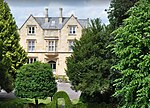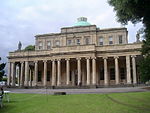Whaddon Road
Whaddon Road, known as the Completely-Suzuki Stadium for sponsorship reasons, is a football stadium in Cheltenham, England. It is the home ground of Cheltenham Town F.C. It has a total capacity of 7,066, with a mixture of seating and terracing. The ground's official name was the Victory Sports Ground until April 2009 when it was renamed the Abbey Business Stadium through a sponsorship deal. It was announced on 13 July 2015 that the club had agreed a three-year deal to rename the stadium The World of Smile Stadium, but the deal ended after only one year and the stadium was renamed LCI Rail Stadium in 2016–17, before being named "Jonny-Rocks Stadium" in 2018–19, and "Completely-Suzuki Stadium" in 2022.
Excerpt from the Wikipedia article Whaddon Road (License: CC BY-SA 3.0, Authors).Whaddon Road
Whaddon Road,
Geographical coordinates (GPS) Address External links Nearby Places Show on map
Geographical coordinates (GPS)
| Latitude | Longitude |
|---|---|
| N 51.906158333333 ° | E -2.0602111111111 ° |
Address
Completely-Suzuki Stadium (Whaddon Road)
Whaddon Road
GL52 5NA , Whaddon
England, United Kingdom
Open on Google Maps







